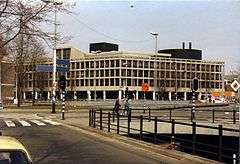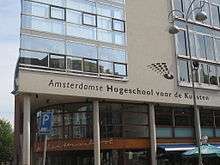Maupoleum
| Burgemeester Tellegenhuis Maupoleum | |
|---|---|
 Maupoleum | |
 Former location of the building | |
| General information | |
| Location | Jodenbreestraat, Amsterdam |
| Coordinates | 52°22′9.34″N 4°54′10.32″E / 52.3692611°N 4.9028667°ECoordinates: 52°22′9.34″N 4°54′10.32″E / 52.3692611°N 4.9028667°E |
| Completed | 1971 |
| Demolished | 1994 |
| Owner | Philips' retirement fund |
| Design and construction | |
| Architect | Piet Zanstra |
The Maupoleum (1971–1994) was a building on Amsterdam's Jodenbreestraat. Built in 1971, it acquired a reputation for being unattractive before being demolished in 1994.
History
The Waterlooplein area of Amsterdam had been a mostly Jewish neighborhood. After World War II, during which much of its population was removed, the area was a "depopulated, impoverished neighbourhood". Plans to rebuild the area included a "circulation route" to open up the inner city, which was to run from the Amstel station to the Centraal station. The northeastern side of the Jodenbreestraat had been designated as a market in a 1953 city plan, but in 1968 these plans were adapted and a mixed building, combining office space for the University of Amsterdam with space for the textile wholesalers of the nearby Sint Antoniesbreestraat.[1]
The building's location was alongside a planned four-lane highway[2] that was to lead to the newly built IJtunnel; in the end, that highway was scrapped, since the further demolition necessary for the project was halted after the Nieuwmarkt Riots of 1975.[3] In addition, the "Central Business District", which the city had envisioned as large enough to include the new building, was never extended as far.[1] As a result, the Maupoleum remained isolated, without an environment which it could blend in with:[4] "What should have been a marked orchestration of the flow to and from the city centre was now reduced to an incursion, a mere incident. The Maupoleum was made to look ridiculous: 'It’s standing alone there out on a limb', [architect] Zanstra conceded some years later".[1]
The building was designed by architect Piet Zanstra and built by a consortium of real estate developers that included the well-known businessman Maup Caransa, funded by technology manufacturer Philips's retirement fund.[5] Though it was officially named "Burgemeester Tellegenhuis" for former Amsterdam mayor Jan Willem Tellegen, it received its nickname as a play on "mausoleum" and Caransa's first name.[6][7] It was 180m long[8] and housed offices and classrooms for the University of Amsterdam, and initially the Amsterdam beauty commission thought it attractive enough,[5] and "only one member of the amenities authority questioned 'whether this modern architecture might clash with the surrounding development'".[1] However, it quickly acquired a reputation for being the ugliest building in the country,[9] "one of the most horrible buildings one could imagine", according to urban planning historian Cordula Rooijendijk.[10] Architect Jaap Huisman, publisher of a survey of the fifty ugliest buildings in the country, gave the building an "honourable place" and commented that it was "presumably the most hated building in the centre of Amsterdam",[11] and Denise van Hoogstraten, in an article in architectural magazine Volume, even compared it to an abscess: "The carbuncle had to be cut away".[1] For many Amsterdammers, the "grey, looming giant came to symbolize the arrogant, large-scale plans of the Amsterdam municipality".[5] Van Hoogstraten also used the language of symbolism: the Maupoleum "symbolize[d] all that was ugly and lacking in quality".[1]

Though there were some efforts to preserve the Maupoleum as an example of 1960s architecture,[12] the building was demolished in 1994,[5] to the relief of many.[13] The work was done by Utrecht company Van Vliet, and generated 11,000 tons of rubble and 700 tons of refuse. The basements were left intact, and on top rose a Teun Koolhaas-designed building with offices for the Amsterdam School of the Arts and a store for supermarket chain Albert Heijn.[5] The brick building has shops and cafes on the ground floor, behind a shopping arcade.[13] While the Maupoleum had been criticized for its size, the new building was constructed on the same scale, though it seems to have escaped similar criticism.[3]
References
- 1 2 3 4 5 6 Hoogstraten, Dorine van (1997). "Bouwen in de binnenstad. Theaterschool en kantoorgebouw in Amsterdam / Building in the inner city. Theatre School and office premises in Amsterdam". Volume. 5.
- ↑ Vletter, Martien de (2004). De kritiese jaren zeventig. NAi. p. 182.
- 1 2 Mens, Noor (2004). ZZDP, architecten-ondernemers (in Dutch). 010 Publishers. pp. 15, 59. ISBN 9789064505133.
- ↑ Hooimeijer, Fransje; Vrijthoff, Wout Toorn (2008). More Urban Water: Design and Management of Dutch water cities. CRC Press. p. 62. ISBN 9780203938508.
- 1 2 3 4 5 Eerenbeemt, Marc van den (18 April 1994). "Maupoleum-sloper loopt zich warm" (in Dutch). Retrieved 6 September 2014.
- ↑ Meeus, Jan (8 August 2009). "Maurits Caransa (1916-2009)". NRC Handelsblad (in Dutch). Retrieved 7 September 2014.
- ↑ Kamp, Justus van de; Wijk, Jan van (2006). Koosjer Nederlands: Joodse woorden in de Nederlandse taal. Contact. ISBN 9789025421793.
- ↑ Rooy, Max van (2007). Het verhaal van de architectuur. Prometheus.
- ↑ Uytenhaak, Rudy (2008). Cities Full of Space: Qualities of Density. 010 Publishers. p. 119. ISBN 9789064506697.
- ↑ Rooijendijk, Cordula (2005). That City is Mine!: Urban Ideal Images in Public Debates and City Plans, Amsterdam & Rotterdam 1945-1995. Amsterdam UP. p. 378. ISBN 9789056293826.
- ↑ Denslagen, Wim (2009). Romantic Modernism: Nostalgia in the World of Conservation. Amsterdam UP. pp. 126–27. ISBN 9789089641038.
- ↑ Wilkinson, Sara J.; Remøy, Hilde; Langston, Craig (2014). Sustainable Building Adaptation: Innovations in Decision-making. Wiley. pp. 173–74. ISBN 9781118477175.
- 1 2 Otten, Harvey (4 July 2012). "vh. het Maupoleum" (in Dutch). Andere Tijden Archi tectuur. Retrieved 6 September 2014.